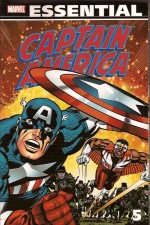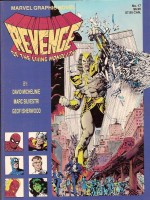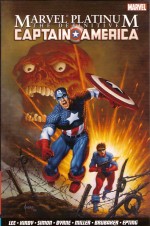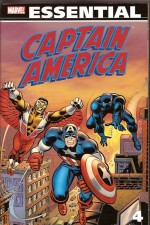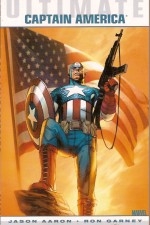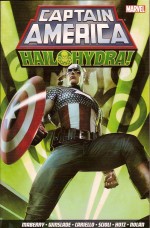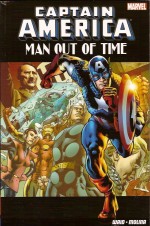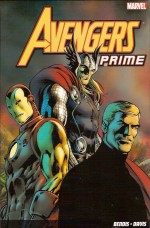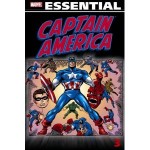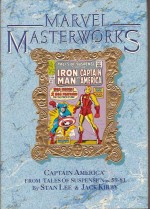
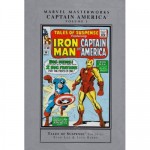
By Stan Lee, Jack Kirby & various (Marvel)
ISBN: 0-87135-630-9Â Â second edition 978-0-7851-1176-4
During the earliest days of Marvel Comics Stan Lee and Jack Kirby emulated the same strategy which had worked so tellingly for National Periodicals/DC, but with mixed results. Julie Schwartz had achieved incredible success with his revised versions of DC’s Golden Age greats, so it was only natural to try and revive characters who had dominated the ailing new kids of Timely/Atlas in those halcyon days of yore. A completely new Human Torch had premiered as part of the revolutionary Fantastic Four and in the fourth issue of that title Sub-Mariner resurfaced after a twenty year amnesiac hiatus (everyone concerned had apparently forgotten the initial abortive attempt to revive the superheroes in the mid-1950s).
Torrid Teen Johnny Storm was promptly given his own solo feature in Strange Tales from issue #101 (as collected in Essential Human Torch volume1) where, in #114 the flaming kid fought a malevolent acrobat pretending to be a revived Captain America. An unabashed test-run, the tales was soon eclipsed when the real McCoy promptly surfaced in Avengers #4. After a captivating and centre-stage hogging run in that title the Sentinel of Liberty was quickly awarded his own series as half of the “split-book†Tales of Suspense, beginning with #59 (after another impostor battled titular star Iron Man in the previous issue).
This magnificent full-colour hardback stirringly re-presents those early short sagas which span the period cover-dated November 1964-September 1966), opening with the initial outing ‘Captain America’, scripted by Stan Lee and illustrated by the staggeringly perfect team of Jack Kirby & Chic Stone: an unapologetic all-action romp wherein an army of thugs invades Avengers Mansion since only the one without superpowers is at home… The next issue held more of the same, when ‘The Army of Assassins Strikes!’, this time attempting to overwhelm the inexhaustible human fighting machine at the behest of arch foe Baron Zemo, whilst ‘The Strength of the Sumo!’ was insufficient when Cap invaded Viet Nam to rescue a captured US airman, after which he took on an entire prison’s population to stop the ‘Break-out in Cell Block 10!’
After these gloriously simplistic romps the series took an abrupt turn and began telling tales set in World War II. ‘The Origin of Captain America’, by Lee, Kirby & Frank Ray (AKA Frank Giacoia – one of an increasing wave of DC stalwarts anonymously moonlighting at the House of Ideas) recounted, recapitulated and expanded the way physical wreck Steve Rogers was selected to be the guinea pig for a new super-soldier serum only to have the scientist responsible die in his arms, cut down by a Nazi bullet.
Now forever unique, Rogers was became a living fighting symbol and guardian of America, based as a regular soldier in a boot camp.
It was there he was unmasked by Camp Mascot Bucky Barnes, who blackmailed the hero into making the boy his sidekick. The next issue (Tales of Suspense #64) kicked off a string of spectacular thrillers as the heroes defeated the spies Sando and Omar in ‘Among Us, Wreckers Dwell!’ before Chic Stone returned for the next tale ‘The Red Skull Strikes!’ in which the daring duo foiled the Nazi mastermind’s sabotage plans in America.
‘The Fantastic Origin of the Red Skull!’ saw the series swing into high gear and switch settings to Europe as sub-plots and characterisation were added to the all-out action and spectacle. ‘Lest Tyranny Triumph!’ and ‘The Sentinel and the Spy!’ (both inked by Giacoia) combined espionage and mad science in a plot to murder the head of Allied Command after which the heroic duo stayed in England for ‘Midnight in Greymoor Castle!’ (with art by Dick Ayers over Kirby’s layouts – rough pencils sketches that break down the story elements on a page). The second part ‘If This be Treason!’ had Golden Age veteran and Buck Rogers newspaper strip artist George Tuska perform the same function. The final part (and the last wartime adventure) was ‘When You Lie Down with Dogs…!’ which added Joe Sinnott inks to the mix for a rousing conclusion to this frantic tale of traitors, madmen and terror weapons…
It was back to the present for Tales of Suspense #72 and Lee, Kirby & Tuska revealed that Cap had been telling war stories to his fellow Avengers for the last nine months. ‘The Sleeper Shall Awake!’ began a spectacular contemporary adventure as a Nazi super-robot was activated twenty years after Germany’s defeat to exact a world-shattering vengeance. Continuing its rampage across Europe in ‘Where Walks the Sleeper!’ before concluding in ‘The Final Sleep!’ this masterpiece of tension and suspense perfectly demonstrated the indomitable nature of the ultimate American hero.
Dick Ayers returned with John Tartaglione inking ‘30 Minutes to Live!’ which introduced both Batroc the Leaper and a mysterious girl who would eventually become Cap’s long-term girl-friend, S.H.I.E.L.D. agent Sharon Carter, in a taut 2-part countdown to disaster ending with ‘The Gladiator, The Girl and the Glory’, illustrated by John Romita (Senior). This was the first tale which had no artistic input from Jack Kirby, but he laid out the next issue (TOS #77) for Romita & Giacoia. ‘If a Hostage Should Die!’ again returned to WWII and hinted at both a lost romance and tragedy to come.
‘Them!’ returned Kirby to full pencils and Giacoia to the regular inks-spot as Cap teamed with Nick Fury in the first of the Star-Spangled Avenger’s many adventures as a (more-or-less) Agent of S.H.I.E.L.D. It was followed by ‘The Red Skull Lives!’ as his arch nemesis returned from the grave to menace the Free World again. He was initially aided by the subversive technology group AIM, but stole their ultimate weapon in ‘He Who Holds the Cosmic Cube!’ (inked by Don Heck) – a device which could rewrite reality with but a whim…
This staggeringly fast-paced, rollercoaster collection climaxes with a classic confrontation in ‘The Red Skull Supreme!’ and concludes with one last breathtaking Cap pin-up by Kirby & Ayers.
These are tales of dauntless courage and unmatchable adventure, addictive and superbly illustrated, which rightly returned Captain America to heights his Golden Age compatriots the Torch and the Sub-Mariner never regained – pure escapist magic.
Great, great stuff for the eternally young at heart, perfectly presented in a sturdy deluxe hardcover edition.
© 1963, 1964, 1965, 1990 Marvel Characters, Inc. All rights reserved.

